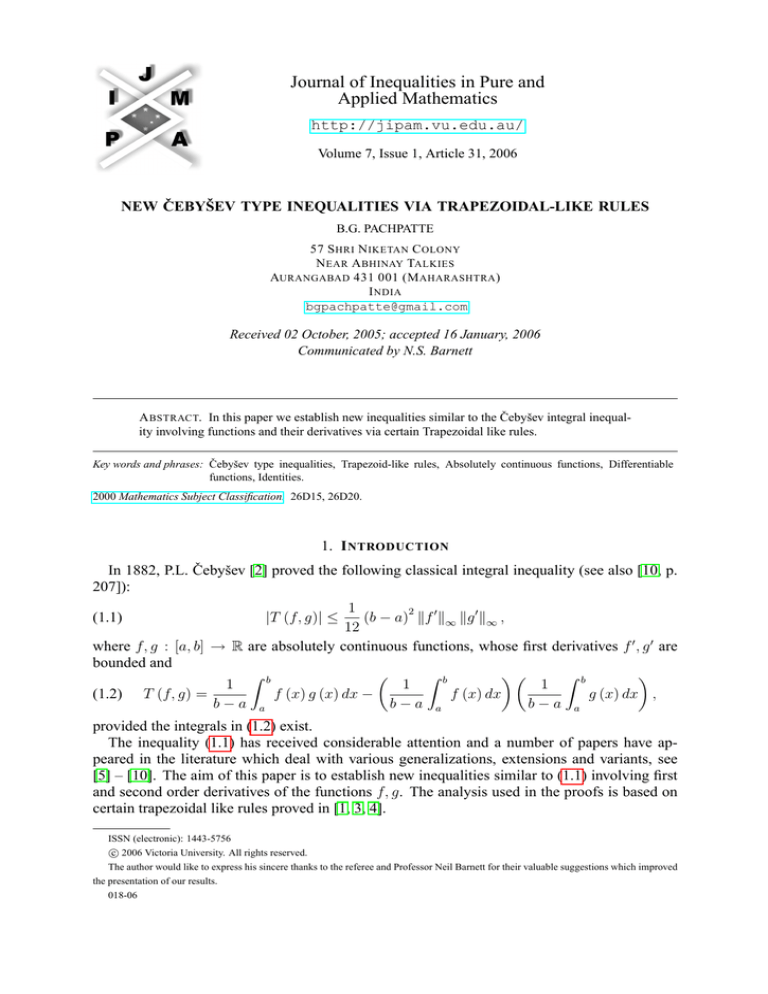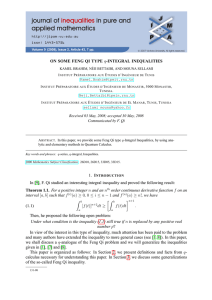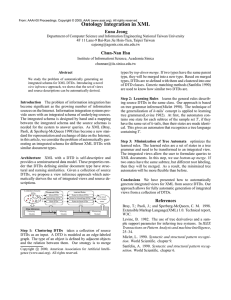
Journal of Inequalities in Pure and
Applied Mathematics
http://jipam.vu.edu.au/
Volume 7, Issue 1, Article 31, 2006
NEW ČEBYŠEV TYPE INEQUALITIES VIA TRAPEZOIDAL-LIKE RULES
B.G. PACHPATTE
57 S HRI N IKETAN C OLONY
N EAR A BHINAY TALKIES
AURANGABAD 431 001 (M AHARASHTRA )
I NDIA
bgpachpatte@gmail.com
Received 02 October, 2005; accepted 16 January, 2006
Communicated by N.S. Barnett
A BSTRACT. In this paper we establish new inequalities similar to the Čebyšev integral inequality involving functions and their derivatives via certain Trapezoidal like rules.
Key words and phrases: Čebyšev type inequalities, Trapezoid-like rules, Absolutely continuous functions, Differentiable
functions, Identities.
2000 Mathematics Subject Classification. 26D15, 26D20.
1. I NTRODUCTION
In 1882, P.L. Čebyšev [2] proved the following classical integral inequality (see also [10, p.
207]):
1
(1.1)
|T (f, g)| ≤
(b − a)2 kf 0 k∞ kg 0 k∞ ,
12
where f, g : [a, b] → R are absolutely continuous functions, whose first derivatives f 0 , g 0 are
bounded and
Z b
Z b
Z b
1
1
1
(1.2) T (f, g) =
f (x) g (x) dx −
f (x) dx
g (x) dx ,
b−a a
b−a a
b−a a
provided the integrals in (1.2) exist.
The inequality (1.1) has received considerable attention and a number of papers have appeared in the literature which deal with various generalizations, extensions and variants, see
[5] – [10]. The aim of this paper is to establish new inequalities similar to (1.1) involving first
and second order derivatives of the functions f, g. The analysis used in the proofs is based on
certain trapezoidal like rules proved in [1, 3, 4].
ISSN (electronic): 1443-5756
c 2006 Victoria University. All rights reserved.
The author would like to express his sincere thanks to the referee and Professor Neil Barnett for their valuable suggestions which improved
the presentation of our results.
018-06
2
B.G. PACHPATTE
2. S TATEMENT OF R ESULTS
In what follows R and 0 denote respectively the set of real numbers and the derivative of
a function. Let [a, b] ⊂ R; a < b. We use the following notations to simplify the detail of
presentation. For suitable functions f, g, m : [a, b] → R, and the constants α, β ∈ R, we set:
Z bZ b
1
L (f ; a, b) =
(f 0 (t) − f 0 (s)) (t − s) dtds,
2
2 (b − a) a a
Z bZ b
1
(f 0 (t) − f 0 (s)) (m (t) − m (s)) dtds,
M (f ; a, b) =
2 (b − a)2 a a
Z b
1
0
00
(t − a) (b − t) {[f 0 ; a, b] − f 00 (t)} dt,
N (f , f ; a, b) =
2 (b − a) a
Z b
Z b
1
P (α, β, f, g) = αβ −
α
g (t) dt + β
f (t) dt
b−a
a
a
Z b
Z b
1
1
f (t) dt
g (t) dt ,
+
b−a a
b−a a
f (b) − f (a)
,
b−a
g (a) + g (b)
a+b
G=
, A=f
,
2
2
[f ; a, b] =
f (a) + f (b)
F =
,
2
F̄ =
f (a) + f (b) (b − a)2 0
−
[f ; a, b] ,
2
12
Ḡ =
Z
t∈[a,b]
B=g
a+b
2
,
g (a) + g (b) (b − a)2 0
−
[g ; a, b] ,
2
12
and define
kf k∞ = sup |f (t)| < ∞,
kf kp =
b
p1
|f (t)| dt
< ∞,
0
p
a
for 1 ≤ p < ∞.
Theorem 2.1. Let f, g : [a, b] → R be absolutely continuous functions on [a, b] with f 0 , g 0 ∈
L2 [a, b] , then,
12
(b − a)2
1
2
0 2
(2.1)
|P (F, G, f, g)| ≤
kf k2 − ([f ; a, b])
12
b−a
12
1
2
0 2
×
kg k2 − ([g; a, b])
,
b−a
(2.2)
12
(b − a)2
1
2
0 2
|P (A, B, f, g)| ≤
kf k2 − ([f ; a, b])
12
b−a
12
1
2
0 2
.
×
kg k2 − ([g; a, b])
b−a
Theorem 2.2. Let f, g : [a, b] → R be differentiable functions so that f 0 , g 0 are absolutely
continuous on [a, b] , then,
(2.3)
4
P F̄ , Ḡ, f, g ≤ (b − a) kf 00 − [f 0 ; a, b]k kg 00 − [g 0 ; a, b]k .
∞
∞
144
J. Inequal. Pure and Appl. Math., 7(1) Art. 31, 2006
http://jipam.vu.edu.au/
Č EBYŠEV TYPE I NEQUALITIES
3. P ROOFS OF T HEOREMS 2.1
3
AND
2.2
From the hypotheses of Theorem 2.1, we have the following identities (see [3, p. 654]):
Z b
1
(3.1)
F−
f (t) dt = L (f ; a, b) ,
b−a a
1
G−
b−a
(3.2)
b
Z
g (t) dt = L (g; a, b) .
a
Multiplying the left sides and right sides of (3.1) and (3.2) we get
P (F, G, f, g) = L (f ; a, b) L (g; a, b) .
(3.3)
From (3.3) we have
|P (F, G, f, g)| = |L (f ; a, b)| |L (g; a, b)| .
(3.4)
Using the Cauchy-Schwarz inequality for double integrals,
Z bZ b
1
(3.5)
|L (f ; a, b)| ≤
|(f 0 (t) − f 0 (s)) (t − s)| dtds
2 (b − a)2 a a
21
Z bZ b
1
2
0
0
≤
(f (t) − f (s))
2 (b − a)2 a a
12
Z bZ b
1
2
×
(t − s)
.
2 (b − a)2 a a
By simple computation,
Z bZ b
1
2
(3.6)
(f 0 (t) − f 0 (s)) dtds
2 (b − a)2 a a
2
Z b
Z b
1
1
2
0
0
=
(f (t)) dt −
f (t) dt ,
b−a a
b−a a
and
(3.7)
1
2 (b − a)2
Z bZ
a
a
b
(t − s)2 dtds =
(b − a)2
.
12
Using (3.6), (3.7) in (3.5),
(3.8)
21
1
b−a
2
0 2
|L (f ; a, b)| ≤ √
kf k2 − ([f ; a, b])
.
2 3 b−a
Similarly,
(3.9)
12
1
b−a
2
0 2
|L (g; a, b)| ≤ √
kg k2 − ([g; a, b])
.
2 3 b−a
Using (3.8) and (3.9) in (3.4), we obtain (2.1).
From the hypotheses of Theorem 2.1, we have (see [4, p. 238]):
Z b
1
(3.10)
A−
f (t) dt = M (f ; a, b) ,
b−a a
J. Inequal. Pure and Appl. Math., 7(1) Art. 31, 2006
http://jipam.vu.edu.au/
4
B.G. PACHPATTE
1
B−
b−a
(3.11)
Z
b
g (t) dt = M (g; a, b) ,
a
where m(t) involved in the notation M (·; a, b) is given by
(
t − a if t ∈ a, a+b
2
m (t) =
t − b if t ∈ a+b
,b .
2
Multiplying the left sides and right sides of (3.10) and (3.11), we get
P (A, B, f, g) = M (f ; a, b) M (g; a, b) .
(3.12)
From (3.12),
|P (A, B, f, g)| = |M (f ; a, b)| |M (g; a, b)| .
(3.13)
Again using the Cauchy-Schwarz inequality for double integrals, we have,
Z bZ b
1
|M (f ; a, b)| ≤
|(f 0 (t) − f 0 (s)) (m (t) − m (s))| dtds
2
2 (b − a) a a
21
Z bZ b
1
2
≤
(f 0 (t) − f 0 (s)) dtds
2 (b − a)2 a a
12
Z bZ b
1
×
(m (t) − m (s))2 dtds .
(3.14)
2 (b − a)2 a a
By simple computation,
Z bZ b
1
2
(3.15)
(f 0 (t) − f 0 (s)) dtds
2
2 (b − a) a a
2
Z b
Z b
1
1
2
0
0
=
(f (t)) −
f (t) dt ,
b−a a
b−a a
and
(3.16)
1
2 (b − a)2
Z bZ
a
b
(m (t) − m (s))2 dtds
a
1
=
b−a
Z
b
2
(m (t)) −
a
1
b−a
Z
b
2
m (t) dt .
a
It is easy to observe that
Z
b
m (t) dt = 0,
a
and
Z b
1
(b − a)2
2
m (t) dt =
.
b−a a
12
Using (3.15), (3.16) and the above observations in (3.14) we get
12
1
b−a
2
0 2
(3.17)
|M (f ; a, b)| ≤ √
kf k2 − ([f ; a, b])
.
2 3 b−a
J. Inequal. Pure and Appl. Math., 7(1) Art. 31, 2006
http://jipam.vu.edu.au/
Č EBYŠEV TYPE I NEQUALITIES
5
Similarly ,
12
1
b−a
2
0 2
kg k2 − ([g; a, b])
.
(3.18)
|M (g; a, b)| ≤ √
2 3 b−a
Using (3.17) and (3.18) in (3.13) we get (2.2).
From the hypotheses of Theorem 2.2, we have the following identities (see [1, p. 197]):
Z b
1
(3.19)
f (t) dt − F̄ = N (f 0 , f 00 ; a, b) ,
b−a a
1
b−a
(3.20)
Z
b
g (t) dt − Ḡ = N (g 0 , g 00 ; a, b) .
a
Multiplying the left sides and right sides of (3.19) and (3.20), we get
(3.21)
P F̄ , Ḡ, f, g = N (f 0 , f 00 ; a, b) N (g 0 , g 00 ; a, b) .
From (3.21),
P F̄ , Ḡ, f, g = |N (f 0 , f 00 ; a, b)| |N (g 0 , g 00 ; a, b)| .
(3.22)
By simple computation, we have,
1
|N (f , f ; a, b)| ≤
2 (b − a)
0
00
Z
b
(t − a) (b − t) |[f 0 ; a, b] − f 00 (t)|dt
a
1
≤
kf 00 (t) − [f 0 ; a, b]k∞
2 (b − a)
(3.23)
Z
b
(t − a) (b − t)dt
a
(b − a)2 00
kf (t) − [f 0 ; a, b]k∞ .
=
12
Similarly,
(b − a)2 00
kg (t) − [g 0 ; a, b]k∞ .
12
Using (3.23) and (3.24) in (3.22), we get the required inequality in (2.3).
(3.24)
|N (g 0 , g 00 ; a, b)| ≤
4. A PPLICATIONS
In this section we present applications of the inequalities established in Theorem 2.1, to
obtain results which are of independent interest.
Let X be a continuous random
R b variable having the probability density function (p.d.f.) h :
[a, b] ⊂ R → R+ and E (x) = a thR(t) dt its expectation and the cumulative density function
x
H : [a, b] → [0, 1], i.e. H (x) = a h (t) dt, x ∈ [a, b] . Then H(a) = 0, H(b) = 1 and
Rb
H(a)+H(b)
= 12 , a H (x) dx = b − E (X).
2
Let f = g = h and choose in (2.1) H instead of f and g and 12 instead of F and G . By
simple computation, we have,
1 1
1
1
b − E (X)
, , H, H = −
(b − E (X)) 1 −
,
P
2 2
4 b−a
b−a
and the right hand side in (2.1) is equal to
1 (b − a) khk22 − 1 ,
12
J. Inequal. Pure and Appl. Math., 7(1) Art. 31, 2006
http://jipam.vu.edu.au/
6
B.G. PACHPATTE
and hence the following inequality holds:
1
1
b
−
E
(X)
−
≤ 1 (b − a) khk2 − 1 .
(b
−
E
(X))
1
−
2
4 b − a
12
b−a
Let a, b > 0 and consider the function f : (0, ∞) → R defined by f (x) = x1 , then f a+b
=
2
a+b
2
g 2 = a+b .
2
Let g = f and choose in (2.2) x1 instead of f and g and a+b
instead of A and B. By simple
computation, we have,
2
2
2 1 1
2
log b − log a
P
,
, ,
=
−
,
a+b a+b x x
a+b
b−a
0 2 2
1
1 (b − a)2
1 −
;
a,
b
=
.
b − a x 2
x
3a3 b3
Using the above facts in (2.2), the following inequality holds:
2
2
log b − log a
(b − a)4
−
≤
.
a+b
b−a
36a3 b3
R EFERENCES
[1] N.S. BARNETT AND S.S. DRAGOMIR, On the perturbed trapezoid formula, Tamkang J. Math.,
33(2) (2002), 119–128.
[2] P.L. ČEBYŠEV , Sur les expressions approximatives des limites, Proc. Math. Soc. Charkov, 2
(1882), 93–98.
[3] S.S. DRAGOMIR AND S. MABIZELA, Some error estimates in the trapezoidal quadrature
rule, RGMIA Res. Rep.Coll., 2(5) (1999), 653–663. [ONLINE: http://rgmia.vu.edu.au/
v2n5.html].
[4] S.S. DRAGOMIR, J. ŠUNDE AND C. BUŞE, Some new inequalities for Jeffreys divergence measure in information theory, RGMIA Res. Rep. Coll., 3(2) (2000), 235–243. [ONLINE: http:
//rgmia.vu.edu.au/v3n2.html].
[5] H.P. HEINIG AND L. MALIGRANDA, Chebyshev inequality in function spaces, Real Analysis
and Exchange, 17 (1991-92), 211–247.
[6] D.S. MITRINOVIĆ , J.E. PEČARIĆ AND A.M. FINK , Classical and New Inequalities in Analysis,
Kluwer Academic Publishers, Dordrecht, 1993.
[7] B.G. PACHPATTE, On trapezoid and Grüss like integral inequalities, Tamkang J. Math., 34(4)
(2003) , 365–369.
[8] B.G. PACHPATTE, New weighted multivariate Grüss type inequalities, J. Inequal. Pure and
Appl. Math., 4(5) (2003), Art. 108. [ONLINE: http://jipam.vu.edu.au/article.php?
sid=349].
[9] B.G. PACHPATTE, A note on Chebychev-Grüss type inequalities for differentiable functions,
Tamusi Oxford J. Math. Sci., to appear.
[10] J.E. PEČARIĆ, F. PORCHAN AND Y. TONG, Convex Functions, Partial Orderings and Statistical
Applications, Academic Press, San Diego, 1992.
J. Inequal. Pure and Appl. Math., 7(1) Art. 31, 2006
http://jipam.vu.edu.au/











